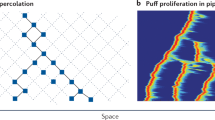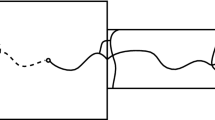Abstract
We present a computationally fast Invasion Percolation (IP) algorithm. IP is a numerical approach for generating realistic fluid distributions for quasi-static (i.e., slow) immiscible fluid invasion in porous media. The algorithm proposed here uses a binary-tree data structure to identify the site (pore) connected to the invasion cluster that is the next to be invaded. Gravity is included. Trapping is not explicitly treated in the numerical examples but can be added, for example, using a Hoshen–Kopelman algorithm. Computation time to percolation for a 3D system having \(N\) total sites and \(M\) invaded sites at percolation goes as \(O(M \log M)\) for the proposed binary-tree algorithm and as \(O(M N)\) for a standard implementation of IP that searches through all of the uninvaded sites at each step. The relation between \(M\) and \(N\) is \(M = N^{D/E}\), where \(D\) is the fractal dimension of an infinite cluster and \(E\) is Euclidean space dimension. In numerical practice, on finite-sized cubic lattices with invasion structures influenced by the injection boundary and boundary conditions lateral to the flow direction, we observe the scaling \(M = N^{0.852}\) in 3D (valid through the second decimal place) instead of \(M= N^{0.843}\) based on the infinite cluster fractal dimension \(D=2.53\).







Similar content being viewed by others
References
Babalievski, F.: Cluster counting: the Hoshen–Kopelman algorithm versus spanning tree approaches. Int. J. Mod. Phys. C 9, 43–60 (1998)
Chen, F., Shinosky, M., Aitken, J., Yang, C.C., Edelstein, D.: Invasion percolation model for abnormal time-dependent dielectric breakdown characteristic of low-k dielectrics due to massive metallic diffusion. Appl. Phys. Lett. 101, 242, 904 (2012)
Glass, R.J., Yarrington, L.: Simulation of gravity fingering in porous media using a modified invasion-percolation model. Geoderma 70, 231–252 (1996)
Hoshen, J., Kopelman, R.: Percolation and cluster distributions. I. Cluster multiple labeling technique and critical concentration algorithm. Phys. Rev. B 14, 3438–3445 (1976)
Knuth, D.E.: The Art of Computer Programming. Sorting and Searching, 2nd edn. Addison-Wesley, Reading, MA (1998)
Krummel, A.T., Datta, S.S., Munster, S., Weitz, D.A.: Visualizing multiphase flow and trapped fluid configurations in a model three-dimensional porous medium. AIChE J. 59, 1022–1029 (2013)
Lenormand, R., Touboul, E., Zarcone, C.: Numerical models and experiments on immiscible displacements in porous media. J. Fluid Mech. 189, 165–187 (1988)
Lovoll, G., Meheust, Y., Toussaint, R., Schmittbuhl, J., Maloy, K.J.: Growth activity during fingering in a porous Hele–Shaw cell. Phys. Rev. E 70, 026301 (2004)
Masson, Y.J., Pride, S.R.: Seismic attenuation due to patchy saturation. J. Geophys. Res. 116, B03, 206 (2011)
Meakin, P., Feder, J., Frette, V., Jossang, T.: Invasion percolation in a destabilizing gradient. Phys. Rev. A 46, 3357–3368 (1992)
Pesheva, N., Stefanov, I., Slavtchev, S.: Application of the invasion percolation model to water–gas flows in artificial soils with plants. Transp. Porous Med. 83, 319–331 (2010)
Sheppard, A.P., Knackstedt, M.A., Pinczewski, W.V., Sahimi, M.: Invasion percolation: new algorithms and universality classes. J. Phys. A Math. Gen. 32, L521–L529 (1999)
Toussaint, R., Lovoll, G., Meheust, Y., Maloy, K.J., Schmittbuhl, J.: Influence of pore-scale disorder on viscous fingering during drainage. Europhys. Lett. 71, 583 (2005)
Toussaint, R., Maloy, K.J., Lovoll, G., Meheust, Y., Jankov, M., Schafer, G., Schmittbuhl, J.: Two-phase flow: structure, upscaling and consequences for macroscopic transport processes. Vadose Zone J. (2012). doi:10.2136/vzj2011.0123
Wilkinson, D.: Percolation model of immiscible displacement in the presence of buoyancy forces. Phys. Rev. A 30, 520–531 (1984)
Wilkinson, D., Willemsen, J.F.: Invasion percolation: a new form of percolation theory. J. Phys. A Math. Gen. 16, 3365–3376 (1983)
Yang, Z., Niemi, A., Fagerlund, F., Illangasekare, T.: Two-phase flow in rough-walled fractures: comparison of continuum and invasion-percolation models. Water Resour. Res. 49, 993–1002 (2013)
Acknowledgments
This material is based upon work supported as part of the Center for Nanoscale Control of Geologic CO2, an Energy Frontier Research Center and as part of the LBNL Geophysics Cluster, both funded by the U.S. Department of Energy, Office of Science, Office of Basic Energy Sciences under Award Number DE-ACO2-05CH11231. Y. Masson has recently been supported through the European Community’s 7th Framework Program (FP-7-IDEAS-ERC), ERC Advanced Grant (WAVETOMO).
Author information
Authors and Affiliations
Corresponding author
Rights and permissions
About this article
Cite this article
Masson, Y., Pride, S.R. A Fast Algorithm for Invasion Percolation. Transp Porous Med 102, 301–312 (2014). https://doi.org/10.1007/s11242-014-0277-8
Received:
Accepted:
Published:
Issue Date:
DOI: https://doi.org/10.1007/s11242-014-0277-8




